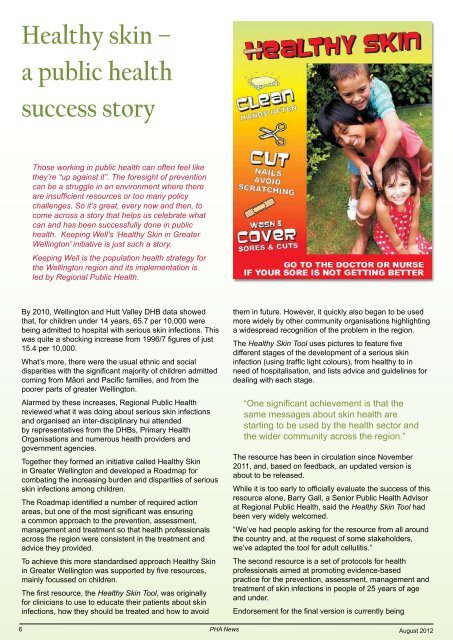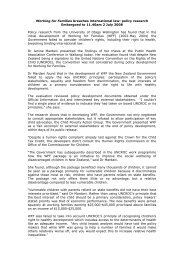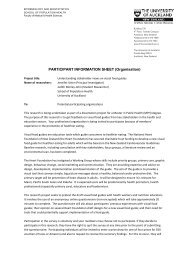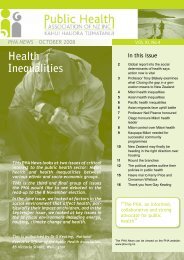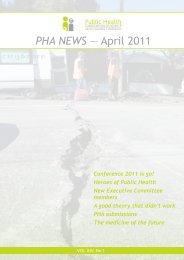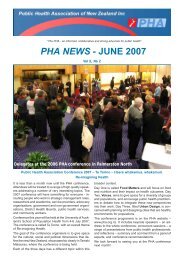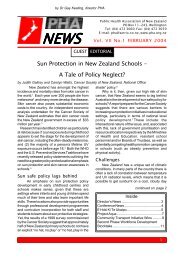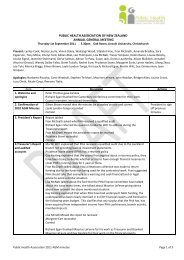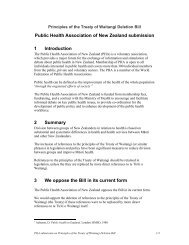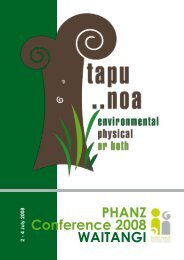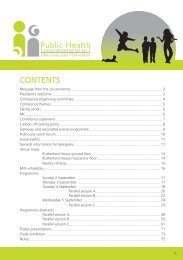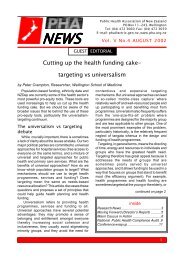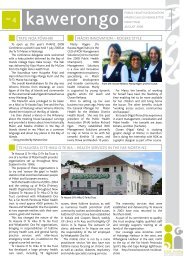August 2012 - Public Health Association of New Zealand
August 2012 - Public Health Association of New Zealand
August 2012 - Public Health Association of New Zealand
- No tags were found...
You also want an ePaper? Increase the reach of your titles
YUMPU automatically turns print PDFs into web optimized ePapers that Google loves.
<strong>Health</strong>y skin –a public healthsuccess storyThose working in public health can <strong>of</strong>ten feel likethey’re “up against it”. The foresight <strong>of</strong> preventioncan be a struggle in an environment where thereare insufficient resources or too many policychallenges. So it’s great, every now and then, tocome across a story that helps us celebrate whatcan and has been successfully done in publichealth. Keeping Well’s ‘<strong>Health</strong>y Skin in GreaterWellington’ initiative is just such a story.Keeping Well is the population health strategy forthe Wellington region and its implementation isled by Regional <strong>Public</strong> <strong>Health</strong>.By 2010, Wellington and Hutt Valley DHB data showedthat, for children under 14 years, 65.7 per 10,000 werebeing admitted to hospital with serious skin infections. Thiswas quite a shocking increase from 1996/7 figures <strong>of</strong> just15.4 per 10,000.What’s more, there were the usual ethnic and socialdisparities with the significant majority <strong>of</strong> children admittedcoming from Māori and Pacific families, and from thepoorer parts <strong>of</strong> greater Wellington.Alarmed by these increases, Regional <strong>Public</strong> <strong>Health</strong>reviewed what it was doing about serious skin infectionsand organised an inter-disciplinary hui attendedby representatives from the DHBs, Primary <strong>Health</strong>Organisations and numerous health providers andgovernment agencies.Together they formed an initiative called <strong>Health</strong>y Skinin Greater Wellington and developed a Roadmap forcombating the increasing burden and disparities <strong>of</strong> seriousskin infections among children.The Roadmap identified a number <strong>of</strong> required actionareas, but one <strong>of</strong> the most significant was ensuringa common approach to the prevention, assessment,management and treatment so that health pr<strong>of</strong>essionalsacross the region were consistent in the treatment andadvice they provided.To achieve this more standardised approach <strong>Health</strong>y Skinin Greater Wellington was supported by five resources,mainly focussed on children.The first resource, the <strong>Health</strong>y Skin Tool, was originallyfor clinicians to use to educate their patients about skininfections, how they should be treated and how to avoidthem in future. However, it quickly also began to be usedmore widely by other community organisations highlightinga widespread recognition <strong>of</strong> the problem in the region.The <strong>Health</strong>y Skin Tool uses pictures to feature fivedifferent stages <strong>of</strong> the development <strong>of</strong> a serious skininfection (using traffic light colours), from healthy to inneed <strong>of</strong> hospitalisation, and lists advice and guidelines fordealing with each stage.“One significant achievement is that thesame messages about skin health arestarting to be used by the health sector andthe wider community across the region.”The resource has been in circulation since November2011, and, based on feedback, an updated version isabout to be released.While it is too early to <strong>of</strong>ficially evaluate the success <strong>of</strong> thisresource alone, Barry Gall, a Senior <strong>Public</strong> <strong>Health</strong> Advisorat Regional <strong>Public</strong> <strong>Health</strong>, said the <strong>Health</strong>y Skin Tool hadbeen very widely welcomed.“We’ve had people asking for the resource from all aroundthe country and, at the request <strong>of</strong> some stakeholders,we’ve adapted the tool for adult cellulitis.”The second resource is a set <strong>of</strong> protocols for healthpr<strong>of</strong>essionals aimed at promoting evidence-basedpractice for the prevention, assessment, management andtreatment <strong>of</strong> skin infections in people <strong>of</strong> 25 years <strong>of</strong> ageand under.Endorsement for the final version is currently being6PHA <strong>New</strong>s <strong>August</strong> <strong>2012</strong>


